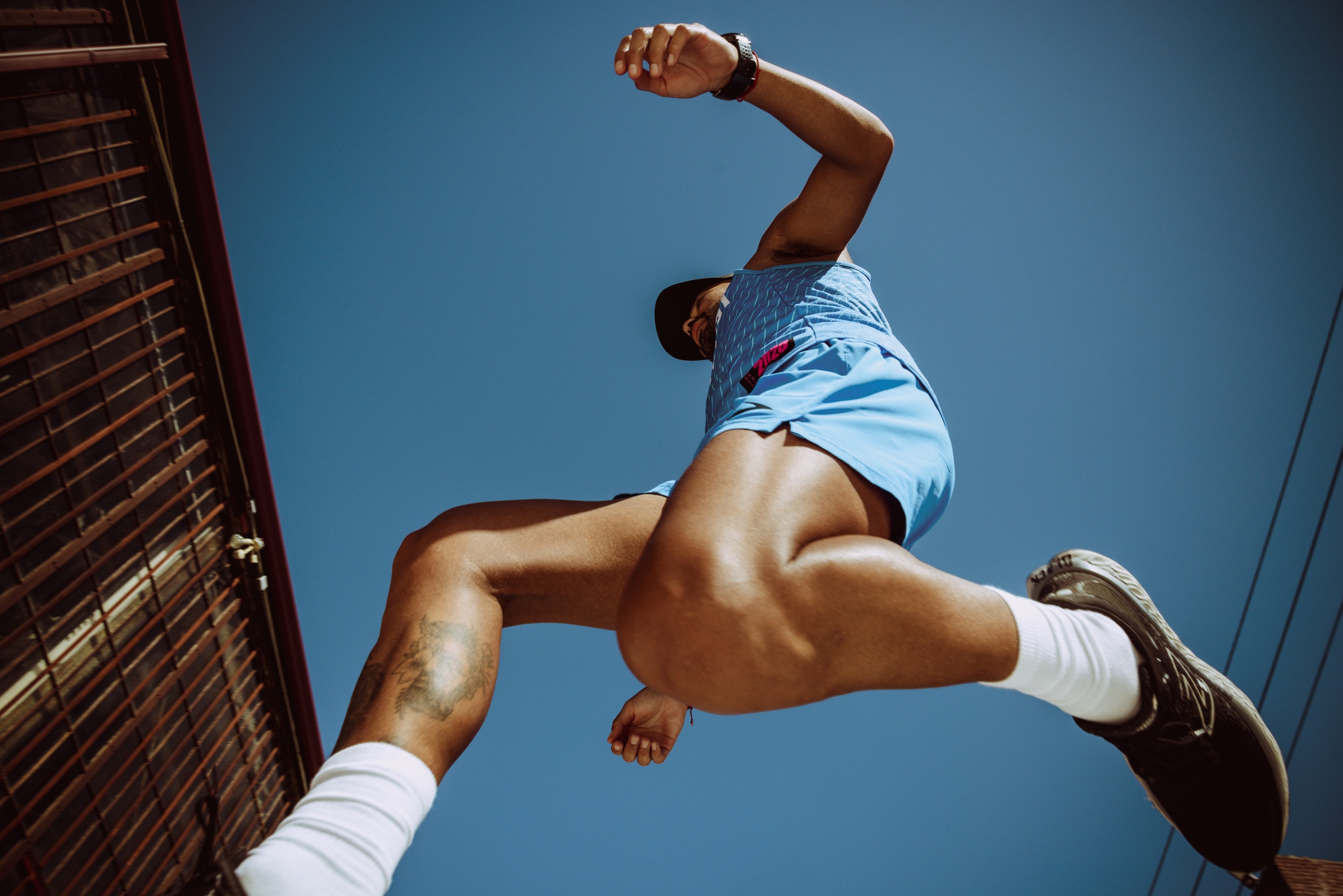All photos by Ashley Batz
Disclaimer: This article is not meant to replace advice from a qualified healthcare professional. Please consult your healthcare provider(s) before taking on any new physical activity.
Any runner who’s done it will confirm: There’s nothing quite like crossing the finish line of a marathon. In that moment, with 26.2 miles of road or trail behind you, all those early mornings and grueling training runs feel worth it; any doubts you’ve carried about finishing are laid to rest; and every obstacle you’ve overcome along the way makes the accomplishment even sweeter.
Before the exhilaration of completion, though, comes the preparation—somewhere between 12 and 20 dedicated weeks of it, depending on your experience and starting fitness. And while there’s no undisputed “right” way to train for a marathon, there are some universal principles that have been tried and tested enough that they’ve found their way into most popular training programs today.
In this article, you’ll learn what you should know before starting a new marathon journey; how to choose your first marathon; what the building blocks of marathon training are; how to optimize your hydration and fueling on race day; and what to keep in mind before, during and after the race.
With your newfound knowledge, a ton of hard work and a little luck, you’ll be calling yourself a marathoner before you know it.
Read on for the full article, or click on the links to jump to a section:
- Getting Started: What to consider before you commit.
- Choosing a First Marathon: Different kinds of races offer different advantages.
- Building Blocks of Marathon Training: Your bread and butter for a strong training block.
- Hydrating and Fueling: It’s important to get this right, with plenty of practice before race day.
- Race Day Tips: Don’t panic. Here’s what you need to know for the big day.
- Race Recovery and Beyond: Once you’ve collected your medal and celebrated your achievement, it’s time to take rest seriously.
Getting Started
Know your limits. Before you embark on any new physical endeavor, it’s a good idea to seek approval from a healthcare professional. They can evaluate your overall health, look for any risk factors and help you determine whether training for a marathon is a sensible idea for you personally. Getting the greenlight from a doctor is especially important if you’re above the age of 40, aware of any physical disabilities, new to running, or returning to the sport after a long break.
Lay a foundation. Although a couch-to-marathon training plan may be tempting, you’ll be much better off if you put in at least a year of consistent running (often called “base mileage”) before trying to tackle 26.2 miles. One of the most common causes of injury in running is building weekly mileage too soon, too fast—so aim to hit at least 20–30 miles a week consistently, and without injury, before committing to training for a marathon.
Still, that doesn’t mean you have to wait a whole year to start racing. You can use that base-building year to train and race your way up in distance, perhaps starting with some 5Ks and 10Ks, building up to a half marathon and then setting your sights on a full marathon.
Consider cross-training. Cycling, swimming, speed-hiking, cross-country skiing and using the elliptical or arc trainer can all work as supplemental or alternative forms of aerobic training to running that involve less impact, potentially allowing you to train more without increased risk of injury. Usually, you’ll want to replace your “easy runs”—your shorter, conversationally paced runs designed to train your aerobic system—with cross-training, while sticking to running for your long runs and speed-work sessions. The conversion should be in time and not in distance, so if a 3-mile easy run typically takes you 30 minutes to complete, an equivalent cross-training session might look like 30 minutes of continuous cycling in heart rate (HR) zone 2. If you have the time, you can also use cross-training to increase your weekly volume without adding much additional stress to your body—so a 30-minute easy run may instead become an hour-long elliptical ride.
Read more: Heart Rate Zones Training Guide and How to Train for a 5+ Hour Marathon
Establish accountability. One of the best ways to ensure consistency with your training and to keep the pursuit fun is to share the journey with others. Depending on your schedule, that may mean recruiting a friend or two to run with you on a regular basis, joining a local running club, hiring an in-person or virtual coach, or getting in on some friendly competition through a fitness logging platform such as Strava.
Choosing a First Marathon

Test it out with shorter races. Marathons range from quiet, low-key races on backcountry roads to spectator-lined urban races with tens of thousands of runners. To experience the atmosphere of a road race and identify the elements that interest you most, you can race some shorter distances, cheer on a running buddy or volunteer at a local race.
Stay local for ease or travel for adventure. Choosing a marathon close to home may offer a "home field advantage" with the opportunity to run on familiar roads, sleep in your own bed and receive encouragement from friends and family. On the other hand, choosing a destination race (any race that requires travel by car or plane) can offer another level of motivation in the months leading up to race day.
Do your research. You may also want to research a race’s history and reputation. Certain marathons are designed to be more welcoming to and inclusive of runners of various backgrounds, for example. Whichever route you choose, learn as much as you can about the race and the course in advance, including expected weather conditions, course profile (which shows elevation changes) and race weekend logistics.
The Building Blocks of Marathon Training
The primary elements of marathon training are:
- Base mileage. Base miles are the standard fitness-building runs that make up the bulk of your training.
- The long run. One longer run each week improves your cardiovascular and muscular endurance and helps you work up to the full 26.2 miles.
- Speed work. Harder workouts like intervals and tempo runs build fitness and increase your aerobic capacity.
- Strength Training. Protect your body from all that pounding by strengthening your muscles and tissues.
- Rest and recovery. Adequate rest helps prevent injuries and mental burnout.
Base Mileage
Most marathon training plans range from 12 to 20 weeks. The amount of time you need will depend on your starting fitness, which should be assessed relative to your goal, whether it is to finish, enjoy your time on the course or set a personal record. The less experienced you are in the marathon, the more likely you will benefit from a plan that gives you closer to 20 weeks to prepare. First-time marathoners should aim to build their weekly mileage up to at least 20-30 miles before they start training specifically for the marathon. Three to five runs per week is sufficient. The vast majority of these runs should be done at a pace that’s relaxed enough to be able to carry on a conversation. As a rule of thumb, when building mileage, never increase your weekly volume by more than 10-20% from one week to the next.
The Long Run
Once you’re up to 20-30 miles per week, it’s time to incorporate a weekly long run, if you haven’t already. These runs should comprise about 20-25% of your weekly mileage, and increase by a mile or two each week. Every 3 or 4 weeks, scale your long run back by a few miles to give your body a little downtime before you ramp back up again. For example, you might run 12 miles one weekend, 13 miles the next, then 14 miles and then 12 again before moving on to 15 on the fifth weekend.
Because each long run will likely be new territory for you, start out very easy to ensure you can finish strong and build confidence for the next one. Starting conservatively will also serve you well on race day because you'll have energy as the race invetiably gets harder towards the end, so it’s good to practice that patience during your training.
Max distance: Many marathon training plans peak at a long run of 20 miles, logged about 3 weeks out from race day. So where do those last 6.2 miles come from on race day? A combination of accumulated fitness, rest from a built-in tapering period and adrenaline from the atmosphere and competition will carry you to the finish line.
Max time: Similarly, many training plans caution against long runs that exceed 3 hours, since going above that may pose more injury risk than the aerobic benefits on offer. However, some runners may have a hard time reaching their recommended peak long run mileage if they cap at 3 hours. The key, here, is to focus on time over mileage and rely on strength and cross-training to supplement the fitness you build on the road, trail or treadmill.
Speed Work
While it’s possible to run a marathon off of easy-paced miles alone, incorporating some speed work once or twice a week can increase your aerobic capacity, develop strength and prevent the build-up from feeling too monotonous. These harder workouts also offer nice opportunities to practice good form and increase the power of your stride. Intervals and tempo runs are two of the most popular forms of speed work.
Intervals are a set of repetitions of a specific, relatively short distance, run at a substantially faster pace than your standard runs, with recovery jogs or walks in between each rep. For example, you might run 4 x 1-mile at your current half-marathon or 10K pace, which should feel hard during marathon training, with 5 minutes of slow jogging or walking between each one. Shorter intervals, like 400- or 800-meter reps, may be at an even faster clip, like mile or 5K pace, respectively. Even though these intervals should be challenging, they should never be run so hard that you have a difficult time cooling down afterwards or recovering within a day or two.
You can also target effort using heart rate zones, referencing your typical easy-run pace as a baseline or by feel, though it takes experience to know what different efforts should feel like.
Tempo runs are longer than an interval—generally in the range of 4–15 miles, depending on where you are in your training—and run at a challenging but manageable pace, since you won’t have rest. This may be close to your marathon pace but will depend on how your body is adapting to and recovering from training. This kind of workout teaches your body, as well as your brain, to sustain a hard effort over an extended period.
On speed-work days, be sure to warm up and cool down well, with 1-3 easy miles before and after. Dynamic stretching and drills beforehand can also help you run more efficiently from the start and get the most out of the session.
Read more: Speed Training Guide
Strength Training
Yes, running is the focus, but you’ll want to add strength training into your plan to help prevent injury and fortify your muscles and tissues for long training sessions. There are different philosophies, but generally, it’s best to strength train after you’ve run, and on a speed-work day so that your easy-run days remain easy. Here is our guide: Strength and Mobility Training for Runners.
Rest and Recovery
Rest days mean no running. They let your muscles recover from all of the pounding you’ve been doing and help prevent mental burnout. The greatest enemy of any marathoner is injury, and the best protection from injury is rest.
Tapering: When you’re about three weeks out from your marathon, it’s time to start tapering. Begin scaling back on your overall mileage by 10-15% each week (so you’d run ~85% of your peak mileage the first week, ~70% of your peak mileage the second week and ~55% of your peak mileage on race week, including the race itself). While keeping your weekly structure roughly the same, decrease the length of your long runs and speed sessions. Don’t cut out the intensity entirely though, as doing so can make you feel sluggish rather than fresh on race day.
Hydrating and Fueling on the Run
Hydration
Nearly all marathons include hydration and aid stations along the way, sometimes as frequently as every mile but more often every 5K (3.1 miles) or 5 miles. If you plan to carry some of your own fluids on race day, invest in a hydration vest or belt long in advance so you have time to get used to running with it.
While training, of course, you will be doing plenty of long runs without the benefit of aid stations. Some tried-and-true techniques to consider include:
- Carry your own water or sports drink in a hydration pack or belt, or in handheld bottles.
- Do long runs on a short loop course, so you can stash water in one spot along the way.
- Plot your long run route to pass water fountains. (Just make sure that they're turned on in the colder months).
- Stash water bottles along your route the night or morning before your run.
Exactly how much fluid you should consume during the race depends on several factors such as your access to fluids, the weather on race day, your individual sweat rate and the amount of time you’ll spend running. But as a general guideline, try to take in roughly 5-10 fluid ounces every 15-20 minutes. Your fluids can be pure water if you’ll be getting carbohydrates and electrolytes from other solid sources, or you can take care of the hydration and nutrition piece together with a carbohydrate-based sports drink with added electrolytes.

Fueling
You've probably heard about the phenomenon many marathoners experience around the 20-mile mark, commonly called "hitting the wall" or "bonking."
Your body can only store so much glycogen, its primary source of energy during an endurance event such as a marathon. As your glycogen gets depleted over the course of the race, your muscles begin to tire, your legs feel increasingly heavy and the pace you’ve been running becomes harder to maintain. While no amount of fuel consumption during the race can entirely replace your depleted glycogen, small and frequent doses of carbohydrates along the way can help prevent you from hitting the dreaded wall.
If your marathon will take you around 3 hours or less, aim to consume 30-60 grams of carbohydrates per hour. Longer than that, and you should shoot for 60-90 grams of carbohydrate per hour. Energy gels and chews pack a powerful punch and are easy to carry, but dried fruit, applesauce packets and sugary candy can also do the trick.
As with everything, make sure to test out various types of fuel on your training runs to determine what you like and what your stomach tolerates best, so you can fuel with confidence on race day.
Race Day Tips
Race day is not the time to experiment with anything new—including shoes, socks, shorts, shirt, pre-race breakfast and mid-race fluid. Your long training runs are when you should be fine-tuning your clothing, gear and fueling strategies.
Here are some other tips to keep in mind as race day approaches:
Before the Race
- Stay hydrated. Carry a bottle with water and electrolytes around with you to sip on in the days leading up to your race.
- Spend some time mentally preparing for the task at hand. Mindfulness and positive self-talk are two powerful tools that will help you get the most out of yourself in the race.
- Eat a simple, high-carbohydrate breakfast 2-4 hours before the start of the race. Whatever has worked in training will do, but bagels, oatmeal and bars tend to work well. Bring a snack to the starting line, too, in case you start to feel peckish or are hit with a delay.
- Get to the starting line with plenty of time to warm up, and plan on long port-a-potty lines.
- If it’s a chilly morning, wear old sweats over your race kit that you won’t mind trashing. Then keep them on until you line up, or start the race in them and ditch them somewhere on the course (ideally in a trash can or with a friend).
- Lather up with a little Vaseline or BodyGlide in any areas vulnerable to chafing (which were probably revealed during training runs).
- If you like the idea of people cheering your name, consider displaying it in big, bold letters on your singlet. To make it easy for family and friends to spot you, wear something that will stand out (like bright colors or a distinct pattern), and tell them what to look for in advance.
- If you plan to run with music, check ahead of time whether headphones are allowed on the course; not all marathons permit them. Running with headphones can be dangerous if you can't hear what's happening around you, particularly if you're not on a closed course. There’s also something to be said for hearing the roar of the crowds and being able to communicate with fellow runners. Bone-conduction headphones are a good middle ground.
During the Race
- Start slower than you think you should. It's easy to get caught up in the race-day excitement, but going out too fast usually backfires. You’ll have plenty of time to pick up the pace if you're feeling great.
- Stick with the fueling strategy you planned (and tested) in advance. If you’ll be drinking at aid stations, take your time at each one to ensure you take in as much as you need.
- Rather than thinking of the marathon as one uninterrupted 26.2-mile run, break it down into smaller chunks (5Ks or 5-milers, for example). Then just focus on making it through whatever segment you’re currently in before moving onto the next one.
- Assuming you’ve run smart and are feeling strong towards the end, in the final 10K, make a game out of passing as many people as you can. It can be a fun distraction that also helps you pick up the pace and improve your finishing place.
- If you have friends or family members coming to cheer you on, know which spots on the course to expect them. A little encouragement along the way can be a huge boost.
- Soak in the energy of the spectators and try to view the race as a celebration of all the hard work you put in to get there.
Race Recovery and Beyond
Race day: In the immediate moments after your finish, drink plenty of water or sports drink to kick off the rehydration process. Start snacking as soon as you can, and eat a substantial meal within 2-3 hours. Instead of an easy jog, do some walking and gentle stretching to nudge your muscles into recovery mode.
After race day: Take 2-4 weeks completely off running and other structured exercise before resuming any kind of regular training schedule. Once you feel physically and mentally ready to start back up, take your time easing back in, and expect to feel stiff and sluggish after the time off.
When the race is behind you, continue implementing the good habits you established during the build-up: Get plenty of sleep. Eat well-balanced meals. Stay hydrated. Have a healthcare professional check out any injuries that may have sprung up during the race.
Finally, enjoy your well-earned status as a marathoner!
More articles from REI experts:


